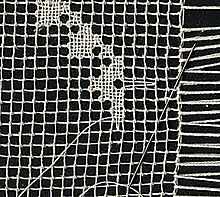Filet lace
Filet lace (also known as Embroidery on Knotted Net, Lacis, Filet Brodé and Poinct Conté) is a needle lace created by darning on a ground of knotted net or netting.
History
Filet lace is a form of decorative netting and as such can be presumed to have derived at some point from the netmaking that a fishing community would require.
If we agree that the latin word filatorium (normally translated as Network) is being used to describe Filet lace then Jourdain (1904) quotes a reference to Exeter Cathedral possessing four pieces of Filet lace in 1327. Ingram (1922) states that there was a "cushion of net-work in St. Paul's Cathedral so [sic] early as 1295." Such work, in the 14th century, was also described as "opus araneum".[1]
More evidence comes from the publication of a pattern book by Federico de Vinciolo in 1587 which contains approximately 60 patterns which are suitable for Filet lace.
Technique

As mentioned above Filet lace is created on a ground of knotted net. That ground can either be made by the lace maker or as of 2005 purchased commercially in either handmade or machine-made varieties.
Making the net by hand with a netting shuttle / needle and a gauge involves anchoring the piece, using either a heavy cushion (which Carità (1909) recommends be made of lead) or a stirrup around the workers foot. Having a secure anchor against which to maintain tension a square net is made starting from one corner and adding a new mesh on each row until the desired size is reached, then by decreasing. The individual meshes are formed on a gauge which helps ensure a uniform size and are created by knotting to a loop in the previous round.
The net to be worked on is then stretched taut on a frame and the decorative stitches applied.
Many designs involve blocking out the main design in linen stitch, indeed some designs consist entirely of linen stitch. This creates solid and open areas on the piece. Open areas in the design can then be decorated using a variety of other stiches.
Filet Lace is typically created in a single color of thread, usually white or ecru, but many countries have used colors.
References
- ↑ "Filet lace (lace)". Encyclopædia Britannica. Encyclopædia Britannica Online. Retrieved 11 February 2013.
- Carità (1909). Lacis. Sampson Low, Marston & Co.
- Th. de Dillmont (1923). Filet-Guipure. Mulhouse (Frankreich)
- Jourdain, M (1904). "Drawn Thread Work and Lacis". The Connoisseur 10: 235–237.
- Ingram, Caroline Patience (1922). ""Point Compté" or Lace Netting". The Connoisseur 62: 92–94.
- Quinault, Marie-Jo (2003). Filet Lace: Introduction to the Linen Stitch Victoria, BC: Trafford. ISBN 1-4120-1549-9
- Vinciolo, Federico (1587). Les Singuliers et Nouveaux Pourtaicts
External links
- Filet Lace – Virtual Museum of Textile Arts
- "Filet Lace by the Sea". Retrieved February 12, 2007.
- "Filet-Guipure (Part 1)" (PDF). Filet-Guipure [Filet Lace], Th de Dillmont, 1923. Retrieved June 2, 2005.
- "Filet-Guipure (Part 2)" (PDF). Filet-Guipure [Filet Lace], Th de Dillmont, 1923. Retrieved June 2, 2005.
- "Vinciolo" (PDF). I Singolari e Nuovi Disegni 1606 (1909 facsimile). Retrieved June 2, 2005.
- "Digital Archive of Documents Related to Lace". University of Arizona. Retrieved June 13, 2005.
| |||||||||||||||||||||||||
